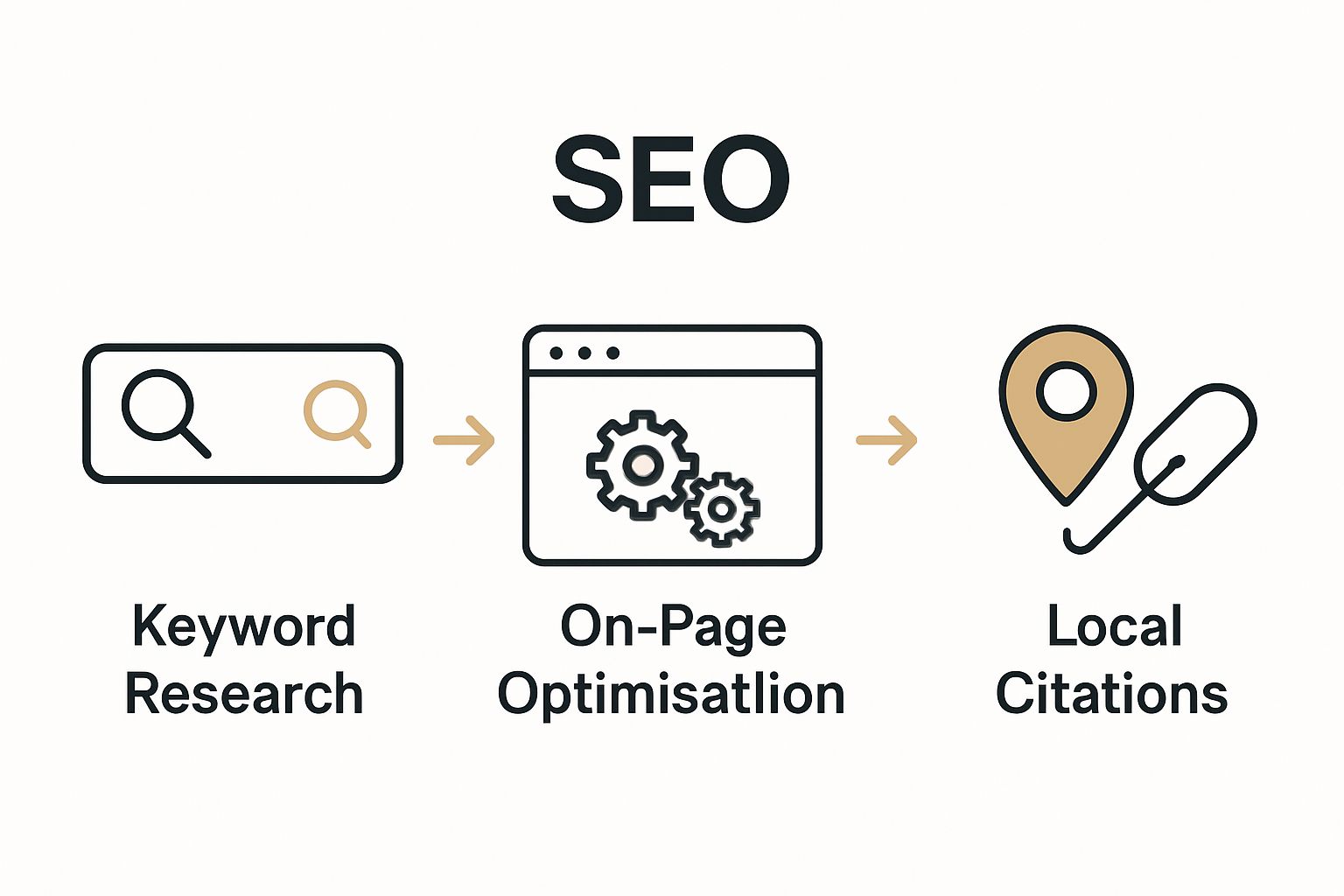Running a hair salon is about more than just scissors and great colour. These days, your online presence can make or break your business. Believe it or not, inconsistent details on platforms like Google can seriously damage your local search ranking and cost you clients. Most salons obsess over perfecting their social posts, but the smartest step is a proper digital health check before anything else.
Table of Contents
- Step 1: Evaluate Your Current Online Presence
- Step 2: Research Relevant Keywords For Your Salon
- Step 3: Optimize Your Website For SEO
- Step 4: Create Quality Content And Blog Posts
- Step 5: Build Local Citations And Backlinks
- Step 6: Monitor, Analyze, And Adjust Your SEO Strategy
Quick Summary
| Key Point | Explanation |
|---|---|
| 1. Evaluate Your Online Presence | Conduct a digital footprint assessment to identify strengths and weaknesses before implementing SEO strategies. |
| 2. Perform Keyword Research | Use tools to find specific, relevant keywords that clients are using to search for salon services locally. |
| 3. Optimize Your Website | Ensure your website loads quickly and is mobile-friendly, with keyword-rich content and clear structure for SEO success. |
| 4. Create Quality Content | Develop informative blog posts that answer client questions while integrating keywords for better search visibility. |
| 5. Monitor and Adjust Your Strategy | Regularly track performance metrics and adapt your SEO strategy based on user behavior and changing trends. |
Step 1: Evaluate Your Current Online Presence
SEO for hair salons begins with a comprehensive understanding of your current digital footprint. Before diving into complex optimization strategies, you need a clear snapshot of where your online presence stands right now. This initial assessment will serve as your strategic baseline for future improvements.
Start by conducting a thorough audit of your existing digital channels. Open your web browser and search for your salon’s name. What appears in the first few search results? Are these listings accurate and professional? Check Google My Business, Yelp, and other local directory listings to ensure your salon’s name, address, phone number, and operating hours are consistent across all platforms. Inconsistent information can significantly harm your local search rankings.
Next, examine your website and social media profiles with a critical eye. Use free tools like Google PageSpeed Insights to evaluate your website’s performance and loading speed. Slow websites frustrate potential clients and negatively impact search engine rankings. Assess your website’s mobile responsiveness, as most clients will search for salon services on their smartphones.
For social media analysis, review your current follower engagement, content quality, and posting frequency. Are your posts showcasing your salon’s unique style and services? Take screenshots of your current digital profiles and create a simple spreadsheet to track key metrics such as:
- Number of followers on each platform
- Average engagement rate
- Frequency of posts
- Quality of existing visual content
Additionally, explore our guide on social media strategies to understand how to enhance your online visibility beyond basic listings. The goal of this initial step is not perfection but creating a clear, honest assessment of your current digital landscape. By understanding your starting point, you can develop targeted strategies to improve your salon’s online presence and attract more potential clients.
Remember that this evaluation is an ongoing process. Digital landscapes change rapidly, so plan to revisit and update your assessment quarterly to stay ahead of emerging trends and technologies.
Below is a tools and resources table to organise the main SEO tools and digital resources mentioned for hair salon optimisation, alongside their purpose in your strategy.
| Tool/Resource | Purpose |
|---|---|
| Google My Business | Manage local business listings and boost local SEO |
| Google Keyword Planner | Research relevant search keywords |
| Google Trends | Track keyword popularity and seasonality |
| Google PageSpeed Insights | Assess website loading speed and technical health |
| Google Analytics | Monitor website traffic and user engagement |
| Google Search Console | Track search visibility and diagnose SEO issues |
| Moz Local / BrightLocal | Audit and monitor local citations and business listings |
Step 2: Research Relevant Keywords for Your Salon
Keyword research forms the strategic foundation of effective SEO for hair salons. This critical step transforms how potential clients discover your business online by understanding the precise language they use when searching for hair services. Instead of guessing what people might type, you will systematically uncover the exact search terms driving local client traffic.
Begin your keyword exploration using free tools like Google Keyword Planner and Google Trends. These platforms reveal search volumes and regional variations in hair service terminology. For a hair salon, you want to capture terms beyond generic phrases like “haircut” and drill into more specific, location-based searches such as “balayage in Perth” or “best hair colour salon near me”.
Pro Strategy: Think like your ideal client. What specific services do you offer? Break down your keywords into categories such as:
- Service-specific keywords (“keratin treatment”, “bridal hair styling”)
- Location-based keywords (“hair salon in [your suburb]”, “hair colouring [your city]”)
- Problem-solution keywords (“grey hair coverage”, “curly hair specialist”)
Utilize long-tail keywords which are more specific and often have less competition. These detailed phrases might have lower search volumes but significantly higher conversion potential. For instance, “professional blonde highlights for medium hair” will attract more targeted clients than the broad term “hair highlights”.
Compile your discovered keywords into a structured spreadsheet, noting search volume, competition level, and potential relevance to your salon’s specific offerings. This documentation becomes your ongoing SEO roadmap, allowing you to track and refine your keyword strategy continuously.

Remember that keyword research is not a one-time task but an evolving process. Trends in hair styling and client search behaviors change rapidly, so plan to revisit and update your keyword list quarterly. By maintaining an adaptive, data-driven approach, you ensure your salon remains visible and attractive to potential clients searching online.
Step 3: Optimize Your Website for SEO
Website optimization transforms your digital storefront from a passive online presence into an active client attraction engine. Technical SEO acts as the foundation that makes your salon discoverable and appealing to both search engines and potential clients. This step requires methodical attention to multiple elements that signal your website’s quality and relevance.
Start by ensuring your website loads quickly and functions seamlessly across all devices. Google prioritizes mobile-friendly websites, so responsive design is no longer optional. Use tools like Google PageSpeed Insights to diagnose and resolve performance issues. Compress images, minimize unnecessary code, and leverage browser caching to improve loading times. A salon website should showcase your work beautifully without sacrificing technical performance.
Learn more about search optimization strategies that go beyond basic technical requirements. Your website content should incorporate the keywords you discovered in the previous step strategically. Create descriptive, keyword-rich meta titles and descriptions for each page. For a hair salon, this might mean crafting titles like “Professional Hair Styling and Colour Services in [Your City]” instead of generic phrases.
Your website structure matters immensely for SEO performance. Organize your content logically with clear headings and subheadings using H1, H2, and H3 tags. Ensure each page focuses on a specific service or topic, allowing search engines to understand and index your content effectively. Include location-specific information throughout your site to boost local search rankings.
Key elements to optimize include:
- Page titles reflecting specific services
- Alt text for all images showcasing your work
- Clear, descriptive service descriptions
- Contact information consistent with Google My Business listing
Consider adding client testimonials, service galleries, and regularly updated blog content to demonstrate expertise and keep your website dynamic. Search engines reward websites that provide fresh, valuable information. By treating your website as an evolving marketing tool rather than a static brochure, you create opportunities to climb search rankings and attract more potential clients.
Verify your optimization efforts by periodically checking your website’s performance using Google Search Console and analyzing your search visibility and organic traffic trends.
Step 4: Create Quality Content and Blog Posts
Content creation is the heartbeat of your salon’s SEO strategy, transforming your website from a static digital brochure into a dynamic, engaging platform that attracts and retains potential clients. The goal is to produce valuable, informative content that answers your clients’ most pressing hair and styling questions while strategically incorporating your carefully researched keywords.
Start by developing a content calendar that aligns with your salon’s services and your clients’ interests. Consider topics that showcase your expertise and address common hair care challenges. For instance, a blog post titled “Top 5 Hair Colour Trends for Summer” or “How to Maintain Healthy Hair Between Salon Visits” can provide genuine value while subtly highlighting your professional skills. Learn more about nurturing online leads through strategic content to understand how valuable content drives client engagement.
Your content should be more than just a sales pitch. According to Content Marketing Institute, successful content provides genuine value to your audience. This means creating in-depth, original articles that offer practical advice, showcase your stylists’ expertise, and solve real problems for your potential clients. Include high-quality images of your work, before-and-after transformations, and detailed explanations of various hair treatments and techniques.
When writing blog posts, integrate your keyword research strategically. Use your target keywords naturally within the content, ensuring they fit contextually and enhance readability. Avoid keyword stuffing, which can harm your search rankings. Instead, focus on creating comprehensive, well-researched content that genuinely helps your readers.
Key elements of compelling salon content include:
- Step-by-step hair care tutorials
- Expert advice on maintaining different hair types
- Seasonal styling recommendations
- Behind-the-scenes insights into salon techniques
- Client transformation stories
Remember that consistency is crucial. Aim to publish new content regularly, whether weekly or bi-weekly, to keep your website fresh and signal to search engines that your site is active and relevant. Promote your blog posts across social media platforms to increase visibility and drive traffic back to your website.

Verify the success of your content strategy by tracking metrics such as page views, time spent on page, and the number of new client inquiries generated through your blog posts. These indicators will help you refine your content approach and continue improving your salon’s online visibility.
Step 5: Build Local Citations and Backlinks
Local citations and backlinks are the digital networking strategy that transforms your salon’s online reputation from isolated to interconnected. Think of these links as professional recommendations that signal your credibility to search engines and potential clients. Building a strong network of quality citations requires strategic outreach and consistent effort.
Begin by ensuring your salon’s business information is consistently listed across all online directories. Accuracy is critical – your business name, address, phone number, and website must be identical everywhere. Start with essential platforms like Google My Business, Yelp, Facebook Business, and industry-specific directories for hair and beauty services. Learn more about generating online leads through strategic networking to understand the broader context of digital marketing connections.
According to local SEO experts at Ahrefs, developing high-quality backlinks requires a multi-pronged approach. Reach out to local businesses complementary to your salon – wedding planners, photography studios, bridal shops – and explore opportunities for mutual website linking. Consider creating collaborative content or offering professional testimonials that include a link back to your website.
Your backlink strategy should prioritize quality over quantity. Local bloggers, community websites, and regional business associations offer excellent opportunities for genuine, relevant backlinks. Attend local networking events, join professional associations, and actively participate in community activities to create natural link-building opportunities.
Key strategies for building authoritative citations include:
- Registering with local chamber of commerce websites
- Participating in community event sponsorships
- Writing guest posts for local lifestyle blogs
- Creating relationships with complementary local businesses
- Encouraging satisfied clients to leave reviews on multiple platforms
Pro Tip: Track your citation building using tools like Moz Local or BrightLocal, which help monitor your online listings and identify potential inconsistencies. Regularly audit your online presence to ensure all information remains current and accurate.
Verify your progress by monitoring your domain authority, tracking the number of quality backlinks, and observing improvements in your local search rankings.
Use this checklist table to help you verify steps when building local citations and backlinks for your salon, ensuring accuracy and a strong online presence.
| Checkpoint | What to Look For |
|---|---|
| Consistent business information | Name, address, phone, and web address match everywhere |
| Registration on core directories | Google, Yelp, Facebook, and industry-specific sites |
| High-quality local backlinks | Links from local blogs, community sites, partners |
| Outreach to complementary businesses | Connections with wedding planners, photographers, etc. |
| Guest posts or sponsored content | Features on local lifestyle or beauty blogs |
| Monitoring and auditing citations | Regularly review for errors or outdated info |
| Client reviews on multiple platforms | Collect positive feedback on Google, Yelp, Facebook |
| Remember that building a robust online network is an ongoing process that requires patience, persistence, and genuine community engagement. |
Step 6: Monitor, Analyze, and Adjust Your SEO Strategy
SEO is not a set-and-forget strategy but a dynamic, evolving process that requires continuous monitoring and refinement. Your salon’s digital presence demands regular performance assessment to ensure you remain competitive in an ever-changing online landscape. Think of this step as your digital health check-up, diagnosing strengths and identifying areas for improvement.
Start by setting up comprehensive tracking tools. Google Search Console and Google Analytics provide invaluable insights into your website’s performance. Explore our guide on creating an effective marketing plan to understand how to integrate these analytics into your broader marketing strategy. These platforms reveal critical metrics such as organic search traffic, user engagement, keyword rankings, and conversion rates.
According to Google Analytics Academy, understanding key performance indicators is crucial. Pay attention to metrics like bounce rate, average session duration, and pages per session. A high bounce rate might indicate that your content isn’t meeting user expectations, while longer session durations suggest that visitors find your content valuable.
Pro Tip: Create a monthly reporting ritual where you deep dive into these analytics**. Look for patterns in user behavior, identifying which blog posts attract the most traffic, which keywords drive client inquiries, and how users navigate through your website. This data becomes your roadmap for strategic improvements.
Key metrics to track regularly include:
- Organic search rankings for target keywords
- Website traffic volume and sources
- Conversion rates from website visitors to client bookings
- User engagement metrics
- Local search visibility
Be prepared to pivot your strategy based on these insights. If certain content types or keywords are underperforming, experiment with new approaches. Perhaps a blog post format needs restructuring, or you need to target different long-tail keywords. SEO is about continuous learning and adaptation.
Remember that algorithm updates from search engines happen frequently. Stay informed about industry changes by following reputable SEO blogs and participating in professional forums. Your willingness to learn, experiment, and adjust will determine your salon’s long-term online success. Treat your SEO strategy as a living document that evolves with your business and your clients’ changing needs.
Are You Ready to Dominate Local Searches and Fill Your Salon Seats?
You have just learned how critical it is to get your SEO foundations right, from accurate listings to selecting the perfect keywords and building local authority. It is frustrating knowing your hair salon delivers amazing results, yet your online presence is not converting visits into steady bookings. Maybe your current efforts are falling short and you are struggling to consistently rank above local competitors. You want more than occasional walk-ins—you want a flood of clients who find you first, trust your brand, and book again and again. Your journey to real growth begins when you combine proven strategy with expert guidance.
Explore our approach to scaling service businesses

Join other ambitious beauty entrepreneurs who have transformed their online marketing with Business Warriors. Visit https://jarrodharman.com to see how the Marketing Vortex method can help you move beyond theory to real results. Ready to boost your bookings, lock in premium clients, and secure your spot at the top of Google? Take action today—your future clients are searching for you right now.
Frequently Asked Questions
How can I evaluate my hair salon’s current online presence?
To evaluate your salon’s online presence, start by conducting a digital audit. Search for your salon’s name online, check Google My Business, and ensure consistent information across directories.
What are the most effective keywords to use for my hair salon’s SEO?
Identify specific keywords related to your services and location. Focus on phrases like “bridal hair styling” or “curly hair specialist” to attract targeted clients.
How can I optimize my salon’s website for better SEO results?
To enhance SEO, ensure your website loads quickly and is mobile-friendly. Incorporate relevant keywords in your page titles and descriptions, and maintain a structured site layout for easy navigation.
What type of quality content should my salon blog include?
Create blog posts that address common client questions and showcase your expertise, such as hair care tips or trending styles. Aim for regular updates, like publishing new content weekly or bi-weekly, to keep your website fresh.
How do local citations and backlinks improve my salon’s visibility?
Building local citations and backlinks establishes your salon’s credibility online. Ensure your business information is consistent across directories and seek partnerships with local businesses to create inbound links to your site.
What metrics should I monitor to assess my salon’s SEO performance?
Track key metrics like organic search traffic, conversion rates, and user engagement levels. Set up monthly reviews to identify trends and make necessary adjustments to your SEO strategy.
Recommended
- What is Search Optimisation? A Detailed Understanding – Jarrod Harman
- Understanding the Advantages of Social Media Optimization – Jarrod Harman
- Effective Social Media Growth Strategy for Businesses – Jarrod Harman
- How to Grow Online Business Through Social Media Effectively – Jarrod Harman
- SEO for Restaurants: Simple Strategies to Boost Your Business


